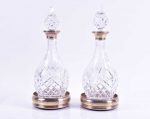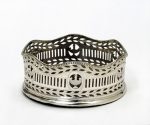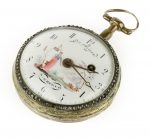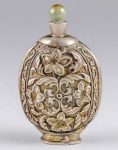Bottle Coasters. Coasters were in popular use by the 1750s. They were invented to enable guests to slide decanters or wine bottles across the table without scratching the surface. They also served to catch drips which might stain the table. Coasters had baize-covered or polished wooden bases (like this one), and later versions sometimes had wheels.
Gentlemen could not drink freely, or at least as much as they wished, until the end of the meal when the ladies had withdrawn to take tea or coffee in the drawing room. The butler laid out the appropriate glasses in front of each guest. He placed the decanters, on coasters, before the master of the house to be passed around in an informal and relaxed atmosphere. Reference: Victoria and Albert Museum
A pair of Victorian sterling silver vintage-decorated wine bottle coasters marks rubbed, Sheffield, 1840 The sides with openwork fruiting grapevines, border with cast branch and vine, and the foot with a ribbon tied reeded band, with wooden bases, diameter 7in (18cm).
Sold for US$ 2,125 (£ 1,595) inc. premium at Bonhams in 2018
A REGENCY SILVER WINE COASTER MARK OF JOHN AND THOMAS SETTLE, SHEFFIELD, 1817 With gadrooned rim and lobed sides, marked to side 5 1/3 in. (14 cm.) diameter; 22 oz. (684 gr.) gross weight
Sold for USD 2,375 at Christies in 2019
A pair of 20th century silver bottle coasters together with a pair of cut crystal decanters and stoppers with silver collars.
Sold for £110 at Dawson’s Auctioneers in 2019
A set of four George IV silver wine bottle coasters, Benjamin Smith, London, 1820 the rims cast with leaf and vine clusters, the centres engraved with coats of arms within leafy scrolls, on turned wood bases 19cm., 7 1/2 in. diameter
Sold for 12,500 GBP at Sothebys in 2017
Coaster, from a set of four. Silver, pierced and engraved with turned wood bottoms. Piercing of vertical slits and vases between foliage borders, pearled wavy edge. An oval plate with the initials ISH added to each.
1779-1780 (made)
Reference: Victoria and Albert Museum






